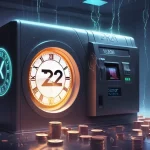Solana Surges Past $200: Can SOL Beat Ethereum & XRP or Is It a Risky Bubble?

Solana Breaks $200: Can SOL Outpace Ethereum and XRP, or Is the Hype a Ticking Time Bomb?
Solana (SOL) has blasted past the $200 mark, igniting bullish fervor with $4.72 billion in capital inflows and skyrocketing on-chain activity. As analysts throw out lofty price targets and whispers of ETF approval grow louder, is Solana poised to dethrone Ethereum and XRP in the altcoin arena, or are we overlooking some glaring red flags? Meanwhile, a new player, Remittix, emerges with promises of real-world utility—but is it substance or just another presale gimmick?
- Price Breakthrough: Solana smashes $200, fueled by massive inflows and adoption spikes.
- Bullish Bets: Predictions range from $255 to $480, hinting at a potential 2.5x jump.
- Hidden Dangers: Network outages and fierce competition cast doubt on Solana’s staying power.
- New Contender: Remittix pushes global payments, but its hype tactics raise eyebrows.
Solana’s $200 Surge: What’s Powering the Rally?
Solana’s recent climb above $200 isn’t just a fluke—it’s a culmination of technical momentum and market confidence. Breaking out of a falling wedge pattern (a chart formation often signaling an upward price reversal after a downtrend), SOL has captured traders’ attention. Data from Glassnode pegs capital inflows at a staggering $4.72 billion, a clear indicator that big money is betting on Solana’s future. Currently hovering at this key level, the blockchain’s appeal lies in its lightning-fast transactions and rock-bottom fees, processing thousands of transactions per second (TPS) compared to Ethereum’s base layer, which chugs along at about 15 TPS. Think of Solana as a multi-lane highway, letting more cars—or transactions—zip through, while Ethereum’s core network resembles a congested two-lane road. For a deeper dive into its technical framework, check out this overview of Solana’s blockchain technology.
This speed advantage has made Solana a go-to for developers in decentralized finance (DeFi) and gaming. For the uninitiated, DeFi encompasses financial tools built on blockchain—lending, borrowing, trading—without banks or brokers. Gaming, meanwhile, includes NFT-driven projects and play-to-earn models where players earn crypto rewards. Solana’s ecosystem is buzzing with activity in these sectors, positioning it as a serious rival to Ethereum, which has long dominated smart contracts but struggles with high fees unless users tap into its scaling solutions. With adoption soaring, Solana’s value proposition is hard to ignore, especially for those chasing scalable, user-friendly tech in the crypto space.
ETF Buzz: A Golden Ticket for Solana?
The hype isn’t just technical—it’s institutional. Bloomberg analysts Eric Balchunas and James Seyffart have upped the odds of a Solana ETF (exchange-traded fund) approval to 95%, with a decision expected by late 2025. Seyffart has even predicted an “altcoin ETF summer,” suggesting Solana, XRP, and Litecoin could see green lights from the SEC in the coming year. An ETF would let traditional investors buy into SOL without touching a crypto wallet, potentially unlocking a tidal wave of Wall Street cash. There’s also talk of the REX Osprey Solana Staking ETF launching as the first U.S.-based crypto staking fund, a move that could further cement Solana’s legitimacy despite the SEC dragging its feet on similar Ethereum products. For more on this development, see the latest analysis on Solana ETF approval odds.
But let’s pump the brakes for a second. While a 95% approval chance sounds like a slam dunk, could an ETF tie Solana too closely to traditional finance’s whims, diluting its decentralized ethos? As Bitcoin purists, we can’t help but raise an eyebrow. Bitcoin doesn’t need an ETF to prove its worth—it’s the unassailable fortress of sound money, battle-tested over a decade. Solana’s shiny new toys are impressive, but tethering its fate to regulatory nods and institutional players feels like a double-edged sword. If it pans out, great; if not, we’re still rooting for tech that disrupts the status quo—just with eyes wide open.
The Dark Side: Network Outages and Cutthroat Competition
Now for the ugly truth: Solana’s track record isn’t spotless. Since its Mainnet Beta launch in March 2020, the network has suffered multiple outages, some grinding things to a halt for as long as 17 hours. A notorious incident in September 2021 saw bot-driven transaction floods during a Raydium IDO (a token launch on a decentralized exchange) overwhelm the system. Technical breakdowns point to issues like delays in how data spreads across the network and inadequate safeguards against spam. Imagine a busy restaurant with no hostess—orders pile up, chaos ensues. That’s Solana under stress. Fixes like prioritizing certain transactions and bug bounty programs (offering up to 25,000 SOL for spotting critical flaws) show effort, but the risk of another crash looms large. For a detailed look at past incidents, explore this history of Solana network outages from 2021-2022.
Then there’s the competition. Ethereum may be slower on its base layer, but its Layer-2 scaling solutions—think Arbitrum with its Nitro upgrade or Optimism’s Bedrock rollout—are slashing fees and boosting speed while leaning on Ethereum’s rock-solid security. These upgrades are like adding express lanes to that congested road, eroding Solana’s edge. Meanwhile, XRP, tied to Ripple, keeps hammering away at cross-border payments, a niche Solana hasn’t fully cracked despite its speed. If Solana stumbles—whether from another outage or failure to innovate—it risks being outmaneuvered by rivals who’ve already weathered their own storms. Community sentiment on platforms like Reddit and Twitter shows cautious optimism, with developers still active on GitHub, but trust isn’t guaranteed if reliability falters again. Some candid discussions on Solana’s reliability challenges can be found in online forums.
Price Hype: Dream or Delusion?
Amid the buzz, analysts are tossing out price targets for Solana ranging from $255 to $480—a potential 2.5x leap from its current $200 level. Let’s be blunt: these numbers are speculative at best, borderline fantasy at worst. There’s no publicly available model or hard data anchoring these predictions, just a lot of hot air. If I had a Satoshi for every moonshot call that fizzled, I’d be sipping cocktails on a private island. Solana’s tech and adoption in DeFi and gaming are promising, no doubt, but justifying such astronomical gains requires more than hype. As Bitcoin maximalists, we see SOL’s role as complementary—filling niches like scalable apps that Bitcoin doesn’t (and shouldn’t) target. But let’s not kid ourselves: altcoins often ride hype cycles that crash as hard as they climb. If you’re betting on SOL, don’t drink the Kool-Aid without a backup plan. For a broader perspective on its market potential, check out this Solana price forecast analysis.
Remittix: Real Utility or Presale Smoke and Mirrors?
Shifting focus, there’s a lesser-known player catching attention: Remittix, a Layer-2 solution on Ethereum aimed at real-world financial use. Unlike meme coins peddling empty promises, Remittix focuses on “PayFi”—a blend of payments and decentralized finance. It supports crypto-to-bank transfers in over 30 countries, offers real-time foreign exchange conversion, and plans a mobile wallet launch in Q3. With $16.6 million raised and over 559 million tokens sold at $0.0811, it’s targeting freelancers and businesses with fast, cheap remittances. A security audit by CertiK, a top blockchain auditor, adds a layer of trust to its infrastructure. On paper, this is the kind of utility we champion—tech that bridges crypto to everyday needs, pushing adoption beyond speculative trading. Learn more about its funding and credibility through this review of Remittix as an Ethereum alternative.
But here’s the catch: Remittix is dangling a $250,000 giveaway for token holders, a classic presale tactic to drum up FOMO (fear of missing out). Reports of XRP and Dogecoin whales piling in only amplify the whiff of speculative manipulation. Utility is fantastic, but when a project leans on giveaways and whale-driven narratives, you have to question if the fundamentals can stand alone. Is “PayFi” a genuine innovation, or just DeFi with a fancy label? Compared to established payment-focused chains like Stellar or Ripple, Remittix has a steep hill to climb. We’re all for accelerating decentralized solutions, but not if they’re just repackaged hype machines destined for a pump-and-dump graveyard. For a closer look at its offerings and presale concerns, see this analysis of Remittix’s PayFi utility.
Altcoin ETFs: Game-Changer or Double-Edged Sword?
Zooming out, the altcoin space is bracing for an institutional wave. Beyond Solana, Bloomberg estimates a 90-95% approval chance for ETFs tied to Dogecoin, Cardano, and Avalanche by Q4 2025. This could flood the market with fresh capital and credibility, potentially separating wheat from chaff—projects with real value might shine, while scams get exposed. Yet, regulatory uncertainty persists. The SEC’s delays on Ethereum staking ETFs and other crypto trusts prove approvals aren’t guaranteed. For Solana and newcomers like Remittix, navigating this maze will be make-or-break. Curious about how Solana stacks up against competitors? This comparison of Solana to Ethereum and XRP offers some community insights.
Here’s a devil’s advocate take: even if ETFs materialize, could they centralize crypto’s rebellious spirit? Institutional money often comes with strings—think increased volatility from retail FOMO or pressure to conform to traditional finance rules. As advocates of decentralization and privacy, we’re torn. We want innovation to race ahead (effective accelerationism in full force), but not at the expense of the core ethos that makes crypto revolutionary. Bitcoin doesn’t bend to Wall Street’s will, and we shouldn’t expect Solana or others to either—ETF or not. For further reading on the potential market impact, take a look at this report on Solana ETF prospects.
Key Takeaways and Burning Questions
- What’s driving Solana’s surge past $200?
A mix of $4.72 billion in capital inflows, a technical breakout, and booming adoption in DeFi and gaming sectors has propelled SOL to this milestone, reflecting strong market trust. - Can Solana outshine Ethereum and XRP in the long run?
Solana’s speed and niche dominance give it a fighting chance, but Ethereum’s scaling upgrades and XRP’s payment focus, combined with Solana’s outage risks, keep the competition fierce. - Are price predictions of $255 to $480 for SOL realistic?
These targets lack concrete backing and scream speculation; while growth is plausible, such aggressive forecasts should be met with heavy skepticism until fundamentals align. - Does Remittix bring genuine value to the table?
Its focus on global payments and crypto-to-bank transfers offers practical utility, but the $250,000 giveaway and whale hype raise concerns about speculative intent over lasting impact. - What’s the broader impact of altcoin ETFs on crypto?
High approval odds could usher in institutional funds and legitimacy for projects like Solana, though regulatory hurdles and risks of centralization threaten the decentralized vision.
Solana’s momentum is electric—its $200 breakout, fueled by DeFi and gaming adoption, and the looming ETF potential paint a bright picture for altcoin enthusiasts. Yet the shadows of past network failures and stiff competition from Ethereum’s Layer-2s and XRP remind us this isn’t a victory lap. Remittix offers a tantalizing glimpse of utility-driven crypto, but its reliance on presale gimmicks is a yellow flag. As we push for a decentralized future, rooted in freedom and disruption, let’s celebrate the innovators but stay sharp. Crypto’s underbelly—hype, crashes, scams—is always lurking, and only the tough will endure. Ask yourself: does Solana’s speed outweigh its risks, or are we safer building on Bitcoin’s unbreakable foundation?



